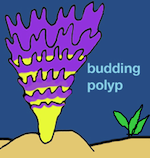What Should Middle School Be?
After nine years of teaching, coaching and counseling young adolescents, Charlie Gramatges has a new job: leading the development of a “true” middle school at independent K12 St. Thomas’ Episcopal in Houston, Texas. Here’s some of what he’s thinking about this summer.
The Middle School kiddo is one quirky animal. In fact, I’ve made an executive decision to align the middle school child with the second stage in development of the common jellyfish. I’m not a biologist, but the ever-ready Wikipedia describes the three stages of jellyfish development as larva, polyp, and medusa. The middle or polyp stage is typically a free-floating, colonial (though sometimes solitary) entity that feeds constantly, and may stay in this state for years before finally deciding to become an adult.
Sounds familiar, right?

It’s our job as educators to make sure that our young, free-floating, always consuming (metaphorically and literally) middle school kids have the same opportunity to thrive and succeed. We must protect them from predators in the form of adults as well as classmates, while teaching them to become “resilient swimmers” working harder when the going gets tough. Unlike the simpler jellyfish, while all this is happening, these kids also need recognition for their successes and opportunities to try new things beyond their everyday experiences that can help them stretch and grow and achieve more.
Social Emotional Learning
Middle schools can have many different uses in a K-12 institution. As my independent school’s grades 6-8 leader, the highest of priorities is to begin the construction of a unique middle school identity for my division. Those schools that develop the very best students do so by teaching key strengths such as time management, goal setting, and resilience during the middle years. In this aspect, the development of Social Emotional Learning (SEL) in and out of every classroom will be an integral umbrella theme during the school year and will remain at the forefront of the daily effort by our middle school faculty.

In Chapter 5 of his book, Dr. Armstrong tells us that the middle school years encompass the developmental stage that is most pivotal in the success of a young girl or boy. The body and mind travel a rocky road during the pre-to-post-pubescent stages of life, and a caring, counseling, edifying academic environment becomes essential to the teaching and learning of an 11-13 year old student. Developing an environment that cultivates these whole-child educational characteristics will prove essential to building the unique identity my school desires of the middle grades.
Educators need to understand the developmental needs of young adolescents, and in particular their neurological, social, emotional, and metacognitive growth. Some of these developmental needs are ignored or subverted by inappropriate educational practices such as fragmented curricula, large impersonal schools, and lesson plans that lack vitality. – Thomas Armstrong, “Middle Schools”
Dr. Armstrong goes on to identify three structural pieces that are key to developing a successful middle school environment: (1) the establishment of teachers who serve as mentors to students, (2) the concept of small communities of learning (rather than high student to teacher ratios), and (3) the encouragement of personalized learning.
Finding what’s best
I believe that the structural necessities Dr. Armstrong describes provide a sturdy framework for the modern SEL environment. The value system a school creates by emphasizing social emotional learning represents the kind of middle school “identity” I’ve been asked to lead the development of in our K12 institution. This will not be an easy endeavor; systemic change never finds Easy Street.
A very wise saying I once heard, many moons ago during a chapel service I attended as a high school student, says that “it’s always easy to know what is GOOD. Good could mean faster, simpler, or a quicker ‘short cut.’ However, it’s not so easy to know what is BEST. Best is the more challenging choice. While GOOD lasts only as long as it’s needed, and then fades into the ether, BEST will last a lifetime.”
[Read another reflection by Charlie Gramatges about his new leadership role at the PLP Voices from the Learning Revolution blog: “I’m a ‘Learner First’ in a Whole New World.”]
Illustration: Smithsonian Ocean Portal
Charles E. Gramatges will become the new Head of Middle School at St. Thomas’ Episcopal in Houston (TX) this fall. Until very recently, he was a middle school mathematics teacher at St. John’s School in Houston, teaching 6th and 7th grade pre-algebra, coaching varsity lacrosse, and serving as an advisor to 6th graders. He writes: “I am very interested in academic innovations via technology and in the great outdoors. From camping to iPads, I thoroughly enjoy discussing ideas regarding ways to stretch the minds of young men and women.” Follow him on Twitter at @cgramatges





































Congratulations on becoming the new Head of Middle School at St. Thomas Episcopal this fall! I work at Stoneleigh-Burnham School, and this fall we begin celebrating the 10th year of our middle school program which I helped found. I have to say, the “polyp stage” metaphor cracked me up. I love my polyps, and one thing about teaching in a 7-12 school is I get to see them grow up in a way many middle school teachers don’t, to find out which pseudopods are retracted (to mix metaphors most horrifically) and which branch out and expand, to get a more specific sense of who the developing adult is becoming.
I appreciate your triumvirate of mentoring, having a small community, and personalizing learning. We, too, work hard to focus on the whole child, and are well aware of the importance of social emotional learning. With an average of 38 kids in the program (7th and 8th grades) over the past three years, I think we can check off “small community.” We work hard to personalize learning, with my Humanities 7 course a democratic classroom and multiple opportunities for personal voice and differentiation throughout the program. For us, then, learning to be effective advisors has been one of the harder tasks, whether it’s guiding kids through the process of preparing for and giving student-led conferences, talking through progress reports, having difficult conversations if something is going wrong, or just finding ways to bond the group together when there’s no school-assigned agenda. It’s an ongoing process – as is all of education, actually.
Thanks again for a great piece.
Bill,
Glad you enjoyed the read. I am quite fond of the middle school years as well…as you probably guessed. The ms is an amazing machine…the kids come in as one thing and leave as something entirely different and exciting. A thrilling place to learn!